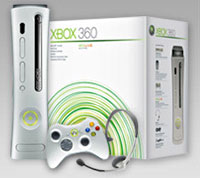 Microsoft appear to be trying the doors of the lucrative movie download business for the Xbox360 with the announcement of a video content deal with music label Epic Records.
Microsoft appear to be trying the doors of the lucrative movie download business for the Xbox360 with the announcement of a video content deal with music label Epic Records.
The partnership will see Microsoft offering exclusive artist content and high-definition music video downloads free to Xbox360 gamers for a year, via the Xbox Live Marketplace service.
Free downloads from twelve up-and-coming artists will be offered through the Artist of the Month (AOM) program, with grandma-untroubling, British singer Natasha Bedingfield kicking off the service.
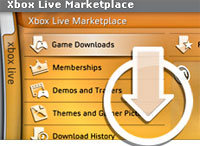 Videos and “exclusive artist content” will also be made available for download from the Xbox site.
Videos and “exclusive artist content” will also be made available for download from the Xbox site.
“Our goal has always been to make Xbox Live a cutting-edge entertainment experience”, insisted Peter Moore, corporate vice president of the Interactive Entertainment Business at Microsoft.
“This agreement with Epic Records offers our members exclusive artistic content directly from the source. With Artist of the Month we will be providing exactly what music-loving gamers want: brand-new, exclusive music videos that can be downloaded quickly, easily and free of charge,” he added.
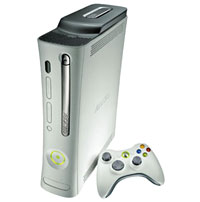 Epic has already dished out music videos for the Xbox 360 from the likes of Franz Ferdinand and Audioslave, and their catalogue also includes acts like Shakira, Matisyahu, Jennifer Lopez and Antipodean dandruff shakers, AC/DC.
Epic has already dished out music videos for the Xbox 360 from the likes of Franz Ferdinand and Audioslave, and their catalogue also includes acts like Shakira, Matisyahu, Jennifer Lopez and Antipodean dandruff shakers, AC/DC.
Each month Microsoft and Epic will announce the new Artist of the Month, along with exclusive benefits for Xbox360 users.
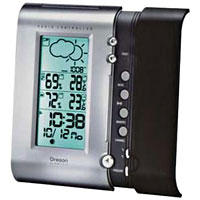 It may not look as pretty as an old fashioned barometer, but Oregon Scientific’s Easy Weather System Pro can provide a wealth of information about the weather – with no need to tap its face to get the dials moving.
It may not look as pretty as an old fashioned barometer, but Oregon Scientific’s Easy Weather System Pro can provide a wealth of information about the weather – with no need to tap its face to get the dials moving.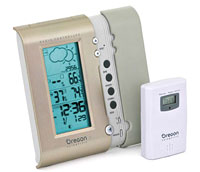 Once set up, the large LCD screen provides indoor and outdoor stats for humidity/humidity trend and temperature/temperature trend as well as barometric pressure/trend (the trend readout displays an arrow to show whether the data is rising, steady or falling.)
Once set up, the large LCD screen provides indoor and outdoor stats for humidity/humidity trend and temperature/temperature trend as well as barometric pressure/trend (the trend readout displays an arrow to show whether the data is rising, steady or falling.)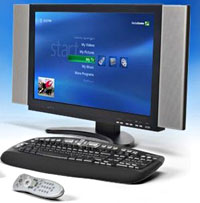 A new report by analyst firm Current Analysis claims that consumers are warming to Media Center PCs, with the entertainment-focused PCs grabbing eight per cent of the US retail market in January 2005, soaring 48 per cent in December.
A new report by analyst firm Current Analysis claims that consumers are warming to Media Center PCs, with the entertainment-focused PCs grabbing eight per cent of the US retail market in January 2005, soaring 48 per cent in December.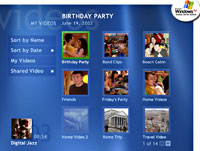 However, tuner-toting Media PCs are already making a comeback, with the market share for TV tuner-equipped systems climbing from 8.7 per cent in October to 12.8 per cent last month.
However, tuner-toting Media PCs are already making a comeback, with the market share for TV tuner-equipped systems climbing from 8.7 per cent in October to 12.8 per cent last month.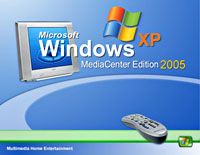 “The upward TV tuner-clad trend is a small victory for Media Center with regard to the digital home,” she said, adding that the TV arena is a “pivotal turf in the war for the digital home because it offers the most opportunities for lucrative infrastructure and broadcast content.”
“The upward TV tuner-clad trend is a small victory for Media Center with regard to the digital home,” she said, adding that the TV arena is a “pivotal turf in the war for the digital home because it offers the most opportunities for lucrative infrastructure and broadcast content.”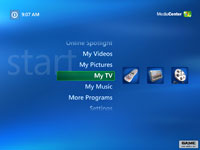 Microsoft first rolled out their Media Center Edition back in October 2002, but consumers have been sniffy because users weren’t inclined to buy the more expensive hardware needed to run the software – neither did the idea of watching TV on a clunky computer monitor seem particularly thrilling.
Microsoft first rolled out their Media Center Edition back in October 2002, but consumers have been sniffy because users weren’t inclined to buy the more expensive hardware needed to run the software – neither did the idea of watching TV on a clunky computer monitor seem particularly thrilling. As voice recorders go (and, let’s be honest, they’re not the most exciting of gadgets) Sony’s new CD-U70/ U50 devices look to be quite natty numbers.
As voice recorders go (and, let’s be honest, they’re not the most exciting of gadgets) Sony’s new CD-U70/ U50 devices look to be quite natty numbers. Battery life is listed as an impressive 140 hours for voice recording and 6 hours for MP3 playback, with the unit offering Digital Pitch Control, Digital VOR (Voice Operated Recording) and 5 message folders to keep your perambulating wafflings filed away neatly.
Battery life is listed as an impressive 140 hours for voice recording and 6 hours for MP3 playback, with the unit offering Digital Pitch Control, Digital VOR (Voice Operated Recording) and 5 message folders to keep your perambulating wafflings filed away neatly.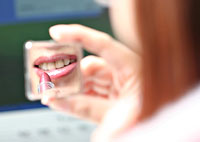 You know the problem: you’ve rushed into work late, sat yourself down at the desk only to realise that there’s not enough USB ports on the machine so you can’t plug in your DVD backup.
You know the problem: you’ve rushed into work late, sat yourself down at the desk only to realise that there’s not enough USB ports on the machine so you can’t plug in your DVD backup. The ‘Mini Mirror Hub’, described as “the most tiny, fashionable USB 2.0 HUB,” can connect up to four USB 2.0 (or USB 1.1) devices, supporting 480Mbps, 12Mbps and 1.5Mbps speeds.
The ‘Mini Mirror Hub’, described as “the most tiny, fashionable USB 2.0 HUB,” can connect up to four USB 2.0 (or USB 1.1) devices, supporting 480Mbps, 12Mbps and 1.5Mbps speeds. USB Ashtray
USB Ashtray USB Heating Gloves
USB Heating Gloves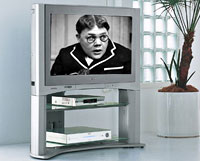 It looks like the days of chunky, clunky cathode ray tube TVs are numbered as worldwide revenues from slimline LCD (liquid crystal displays) TVs surpassed those of cathode-ray (CRT) televisions in the fourth quarter last year.
It looks like the days of chunky, clunky cathode ray tube TVs are numbered as worldwide revenues from slimline LCD (liquid crystal displays) TVs surpassed those of cathode-ray (CRT) televisions in the fourth quarter last year.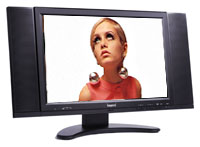 Sales were healthy for plasma-screen televisions, growing 31.3 percent to reach $5.29 billion in the same quarter, giving them the third-largest share of the market after LCD TVs and cathode-ray TVs.
Sales were healthy for plasma-screen televisions, growing 31.3 percent to reach $5.29 billion in the same quarter, giving them the third-largest share of the market after LCD TVs and cathode-ray TVs.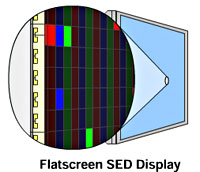 Look out LCDs – here comes SED displays
Look out LCDs – here comes SED displays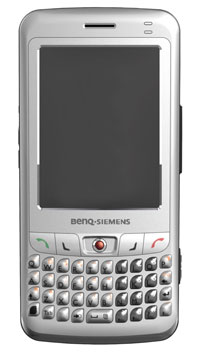 With a veritable orgy of announcements, BenQ Mobile rolled out six new mobile phones at the CeBIT trade show in Germany.
With a veritable orgy of announcements, BenQ Mobile rolled out six new mobile phones at the CeBIT trade show in Germany.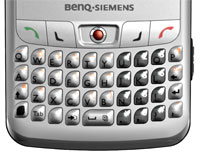 VoIP calls are made possible through the built in 802.11b/g Wi-Fi connectivity and pre-loaded Skype software.
VoIP calls are made possible through the built in 802.11b/g Wi-Fi connectivity and pre-loaded Skype software.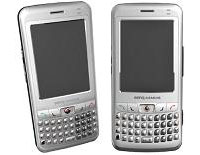 Also announced was the flagship EL71, a tri-band, 16.5mm thin slider phone with a metal casing in brushed aluminium finish. Designed for the “young professional,” the phone sports a 2-inch, 260,000-color QVGA display.
Also announced was the flagship EL71, a tri-band, 16.5mm thin slider phone with a metal casing in brushed aluminium finish. Designed for the “young professional,” the phone sports a 2-inch, 260,000-color QVGA display.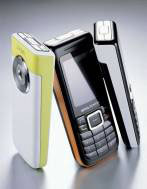 The CL71 slide phone is another slim number (17.8mm) with built-in 1.3-megapixel camera, MP3 player and radio with a 2-inch TFT 262k display offering 176 x 220 picture resolution.
The CL71 slide phone is another slim number (17.8mm) with built-in 1.3-megapixel camera, MP3 player and radio with a 2-inch TFT 262k display offering 176 x 220 picture resolution.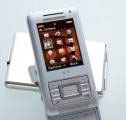 Finally, the wedge shaped E61 comes in orange, yellow, or silver, with a built-in VGA camera with 2x/4x digital zoom.
Finally, the wedge shaped E61 comes in orange, yellow, or silver, with a built-in VGA camera with 2x/4x digital zoom.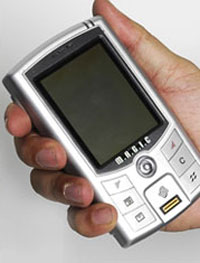 Currently hovering betwixt prototype and retail status, Advance Tech Communications new Windows Mobile smartphone market looks hot! hot! hot!
Currently hovering betwixt prototype and retail status, Advance Tech Communications new Windows Mobile smartphone market looks hot! hot! hot!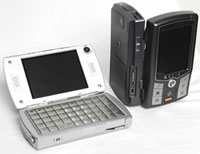 On board storage is taken care of courtesy of a generous 8GB hard disk, backed up by 512MB RAM and 512MB ROM, with a micro-SD expansion card slot.
On board storage is taken care of courtesy of a generous 8GB hard disk, backed up by 512MB RAM and 512MB ROM, with a micro-SD expansion card slot.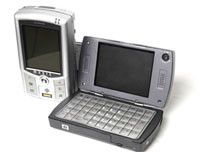 Instead, the company are proclaiming their new device to be a “laptop computer miniaturised to the size of a handheld device,” which perhaps isn’t the snappiest description they could have come up with.
Instead, the company are proclaiming their new device to be a “laptop computer miniaturised to the size of a handheld device,” which perhaps isn’t the snappiest description they could have come up with.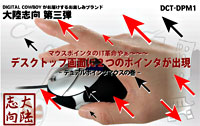 Thanks to innovative manufacturers like Logitech, we’ve had mice (mouses?) with more buttons than a Cinderella reunion, but just when you thought that the humble mouse couldn’t get any more new features, Digital Cowboy have announced the world’s first dual pointer mouse, the DCT-DPM1.
Thanks to innovative manufacturers like Logitech, we’ve had mice (mouses?) with more buttons than a Cinderella reunion, but just when you thought that the humble mouse couldn’t get any more new features, Digital Cowboy have announced the world’s first dual pointer mouse, the DCT-DPM1. The DCT-DPM1 is aimed at people with multiple desktop displays, where users currently have to scroll across hefty distances when they jump from screen to screen.
The DCT-DPM1 is aimed at people with multiple desktop displays, where users currently have to scroll across hefty distances when they jump from screen to screen.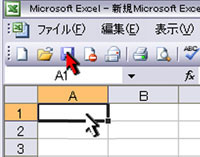 Flipping between the two work areas is then simply a case of activating the mouse button to access the ‘parked’ cursor, without any need for a marathon of cross-screen scrolling.
Flipping between the two work areas is then simply a case of activating the mouse button to access the ‘parked’ cursor, without any need for a marathon of cross-screen scrolling.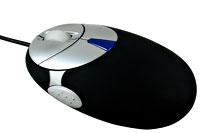 We’ve no idea when, or even if, this bi-cursorary device will be making it to the UK, but it is possible we could be witnessing the next evolution of the mouse.
We’ve no idea when, or even if, this bi-cursorary device will be making it to the UK, but it is possible we could be witnessing the next evolution of the mouse.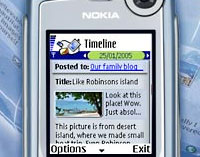 Nokia has launched Nokia Lifeblog 2.0, an updated version of their photo-blogging offering.
Nokia has launched Nokia Lifeblog 2.0, an updated version of their photo-blogging offering.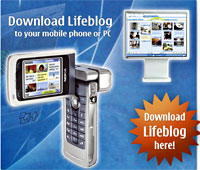 Well, that’s how we’d describe the process, but Nokia has a more flowery interpretation, insisting that adding the extra information is “rendering them as part of the rich tapestry of items that make up your personal Nokia Lifeblog timeline.”
Well, that’s how we’d describe the process, but Nokia has a more flowery interpretation, insisting that adding the extra information is “rendering them as part of the rich tapestry of items that make up your personal Nokia Lifeblog timeline.”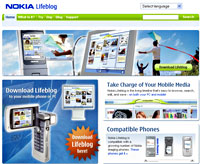 “With imaging becoming an integral part of mobile devices, the way people approach photography is changing. You are able to capture events and create memories in a spontaneous way as your device is always with you,” gushed Mikko Pilkama, whose job title is surely unpronounceable after five beers: Director, Nokia Nseries See New, Multimedia, Nokia.
“With imaging becoming an integral part of mobile devices, the way people approach photography is changing. You are able to capture events and create memories in a spontaneous way as your device is always with you,” gushed Mikko Pilkama, whose job title is surely unpronounceable after five beers: Director, Nokia Nseries See New, Multimedia, Nokia.